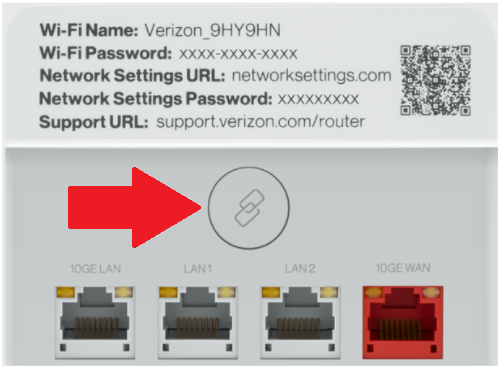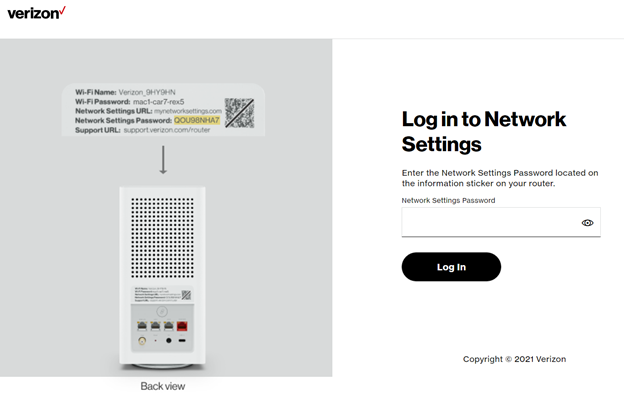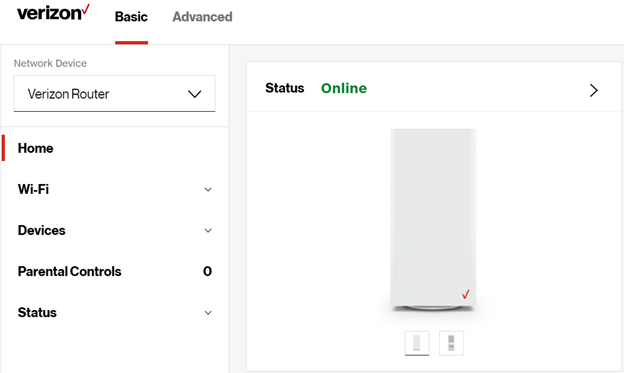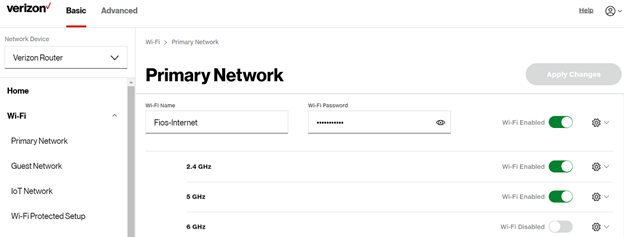|
Due to inactivity, your session will end in approximately 2 minutes. Extend your session by clicking OK below. Due to inactivity, your session has expired. Please sign in again to continue. |
Verizon Router
Get the best out of the Internet with the Verizon Router!
- The latest Wi-Fi generation, Wi-FI 6E, adds support for 6 GHz, providing more spectrum for increased speeds, better coverage and lower latency.
- Supports single Wi-Fi name & password with SON (self organizing network) functionality.
- Automatic band steering.
The default Wi-Fi name & Password Network Settings Password can be found on the rear label of your Verizon Router. Please refer to the illustration below:

Access the Wi-Fi setting on your Wi-Fi device, then select your Verizon Router using the Wi-Fi name or Wi-Fi network name (ESSID) shown on the label located on the back panel of your router. Enter the Wi-Fi password or Wi-Fi password (WPA2 key). The default password/key is also shown on the label.
Note: Verizon recommends that you establish a strong, unique password for your Wi-Fi.
Wi-Fi 6E offers the features and capabilities of Wi-Fi 6—including higher performance, lower latency, and faster data rates—extended into the 6 GHz band. In other words, Wi-Fi 6E provides a new band of Wi-Fi spectrum operating on the 6 GHz frequency that leverages the advanced speeds available with Wi-Fi 6 (which brought 802.11ax support). The 6 GHz band provides up to seven different 160 MHz wide channels to use while the 5 GHz band only has two.
If you have a Wi-Fi 6E device and are experiencing slower speeds in the 5 GHz band, we recommend you switch to Wi-Fi 6E. For further detail on how to turn on Wi-Fi 6E, see question 6 below. The Wi-Fi 6E band uses WPA3 encryption and will switch your primary Wi-Fi network to WPA3 when turned on. If a device with WPA2 encryption is connected to your primary network when you turn on Wi-Fi 6E, that device may disconnect. If so, you can connect it to the IoT network which uses WPA2 encryption.
When you enable Wi-Fi 6E:
- The primary Wi-Fi (2.4 & 5 GHz) will include the 6 GHz band.
- Encryption will change from WPA2 tWPA2/WPA3 mode on the 2.4 & 5 GHz bands.
- WPA3 encryption will be enabled on the 6 GHz band.
- The IoT Wi-Fi will also be enabled for any devices that don’t support WPA3. To connect to IoT Wi-Fi you’ll need to use a unique Wi-Fi name and password.
Wi-Fi 6E is not enabled by default on the Verizon Router. You can turn it on online in the router admin site.
When you turn on Wi-Fi 6E, this will also enable IoT Wi-Fi on your router and will change your encryption mode to WPA2/WPA3 on the 2.4 & 5 GHz, and 6 GHz will be enabled using WPA3. This may cause some devices to disconnect from your network. If so, you may need to reconnect them.
Some devices may need their Wi-Fi drivers updated to support routers which use Wi-Fi 6 (802.11ax). Also, some devices, like TV's and laptops, may not support the latest Wi-Fi technology used by an advanced router, and may need to be disabled.
Note: Intel Wireless adapters supporting 802.11ac with older drivers might not show Wi-Fi 6 (802.11ax) networks. Please verify/update to the latest Wi-Fi drivers.
Yes, Wi-Fi divers should always be updated for optimal Wi-Fi performance. In many cases, but not all, Wi-Fi drivers are automatically updated with auto updates enabled.
Note: Intel Wireless adapters supporting 802.11ac with older drivers might not show Wi-Fi 6 (802.11ax) networks. Please verify/update to the latest Wi-Fi drivers.
Yes, it is supported by default and can be managed within the My Verizon app, My Verizon, or locally on the router. Please visit verizon.com/sonsupport for more SON information.
Sign into My Verizon to set up your Guest Wi-fi. To access:
- hover over Services, select Internet > under My Networks select your Guest Network > select Enable Guest Wi-Fi Access
Don’t have an account?
- Find in My Verizon
- Find on your router
Sign into My Verizon to view your Wi-Fi name and password. To access:
- hover over Services, select Internet > under My Network the password is listed below each network name
Don’t have an account?
The Wi-Fi password is shown on the label located on the back of your Verizon Router.
Please refer to the diagram below:

Your Verizon Router comes with a WPS button that allows for a connection to your Wi-Fi network without manually entering a password. If your Wi-Fi device supports WPS, follow your device manufacturer user’s guide to set up and connect to your network. Use the My Verizon app or visit My Verizon to manage Wi-Fi settings.
Note: Wi-Fi Protected Setup (WPS) cannot be used if WPA3 security is enabled or SSID broadcast is disabled or if MAC address authentication is enabled with an empty white list.
Sign into My Verizon to manage your settings. To access
- hover over Services, select Internet
Don’t have an account?
Verizon Fios internet customers with select routers are eligible for Fios Parental Controls.
Eligible Verizon Router models include:
- Fios Router (G3100 model)
Verizon Router (CR1000A and CR1000B models)
Plug one end of an Ethernet cable into one of the 3 grey Ethernet ports on the back of your router. Plug the other end of the Ethernet cable into the Ethernet port of your network device.
Note: The Verizon Router provides a 10 Gigabit Ethernet LAN port and two 2.5 Gigabit Ethernet LAN ports.
Open your browser and enter "myfiosgateway.com" or "192.168.1.1" into the browser. You will be taken to a page to enter your username and administrator password:
- The default username is "admin"
- The unique default password is on the label located on the back of the router. Please refer to the diagram below

With the Verizon Speed Test tool you’ll be able to test your router speed, device speed and learn ways to optimize your connection. You’ll also be able to measure your network's upload and download speeds.
Sign into My Verizon to test your speed. To access, select Begin Speed Test.
Don’t have an account?
For your protection, your router is preset at the factory to use WPA2 (Wi-Fi Protected Access) encryption for your wireless network. This is the strongest setting for most users and provides maximum security but may prevent older devices from connecting.
Verizon recommends that you establish a strong, unique password for your router. Use the My Verizon app or visit My Verizon to change your default password.
Press and hold the Reset button on the back of the router for 3-5 seconds. Give the router some time to connect to the Internet and wait until the Internet light becomes steady white.

Pressing and holding the red reset button located on the back of the Verizon Router will restore the router to the factory default settings shown on the label located on the back of your router. Use the pointed end of a paperclip to press and hold the reset button for 15 seconds. Important Note: If you have customized your network name and/or password, resetting your Verizon Router to the factory defaults not only changes your router username and password back to the factory default values, but it also deletes all of your home network settings. This includes the ESSID and network encryption key that you created. After you reset your factory defaults, your home network won't be accessible until you reconfigure your router and update all your network devices to use the same customized ESSID and network encryption key (WPA2).
Yes, the router supports Tri-Band Wi-Fi, or 3 unique Wi-Fi bands. This router broadcasts on the 2.4, 5 and 6 GHz bands. By default, the 2.4 and 5 GHz bands are enabled and are managed together by SON to use the same Wi-Fi name and password; and the 6 GHz band is enabled and broadcasting to connect a Verizon Wi-Fi Extender Mini. To connect personal devices as well to the 6 GHz, you can enable it from the My Verizon app to be included within the Primary network, or disable SON and manage all 3 bands independently.
The Internet of Things or IoT network is designed to provide an easier setup experience for your IoT devices. These benefit from connecting to the 2.4 GHz band while keeping your primary network settings unchanged. Devices connected to IoT Wi-Fi are accessible to other devices on the primary Wi-Fi network.
IoT Wi-Fi is generally used:
a) To connect an IoT device that requires an app for set up and doesn’t have a physical input method to set up Wi-Fi directly.
In some cases it may be easier to connect a device to IoT Wi-Fi. In this situation, connect the smartphone, with the IoT app installed, to the IoT Wi-Fi network on the router. Follow the prompts in the IoT app for connecting the device.
b) To connect an older device using WPA2 when you have Wi-Fi 6E turned on.
The Wi-Fi 6E band uses WPA3 encryption. If a device with WPA2 encryption is connected to your primary network when you turn on Wi-Fi 6E, that device may disconnect and not reconnect even after retyping the password. If so, you can connect it to the IoT network which uses WPA2 encryption.
Yes you can easily update your Wi-Fi name and password to your existing credentials through a web browser. Once updated, all of your devices should reconnect easily on their own. No need to reprogram them all individually. Please refer to the instructions below:
1. On the address bar type 192.168.1.1

2. Enter the Network Settings Password and click log in

3. Click on Wi-Fi

4. Select the Primary Network

5. Update the Wi-Fi Name and Wi-Fi Password
6. Click Apply Changes
7. Repeat steps four through six for the two remaining networks if applicable.
Parental Controls
Parental controls are a suite of tools and features available on the Verizon Home app designed to help parents manage their children's use of router-connected devices. Parental controls also include features to manage online content accessible from router-connected devices. They provide a way for parents to set boundaries and guide their children's digital experiences in a safe and age-appropriate manner.
Digital Secure Home FAQs
Digital Secure Home and Digital Secure Home Plus protect devices connected to an eligible Fios router. You can protect connected devices, including non-display devices. Digital Secure Home and Digital Secure Home Plus also safeguard your router-connected devices from online threats and vulnerabilities.


